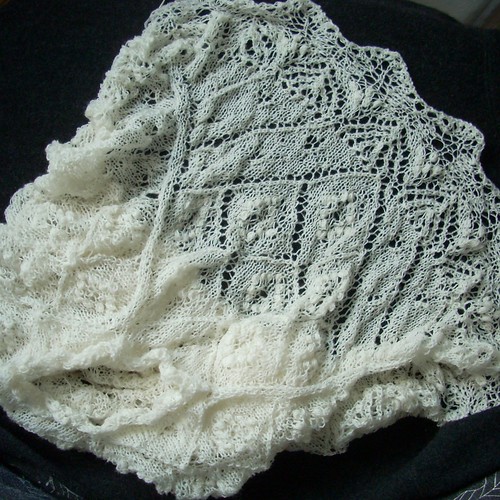Axel Rydströms is a charming shop in Stockholm I recommend if you're looking for buttons. Someone had told me it was the right place to go to find suitable buttons for the 1940s style cardigan, which proved to be correct. Not only are these buttons from the right period, but I also think they look very nice against the shade of green.
It took some time for me to decide what kind of construction I wanted for the neckband. What I did after a couple of false starts was to continue knitting the two ribbed edges after I had reached the shoulder until they were long enough to meet at the centre of the back. Then I cast them off together before sewing (ugh) them in place.
.jpg) |
| Cardigan: back of neck |
The Estonian-Austrialian poncho is also finished, but unfortunately I have misplaced my pins, and therefore haven't been able to block it properly. Once they've turned up I'm going to block it again to make the scalloped borders pointier, but this will do for the time being.
As I mentioned in a previous post, there are both advantages and disadvantages knitting lace patterns and nupps in the round. Because of two major disadvantages I don't think I will knit lace in the round again: always facing the right side I mixed up rows now and then in a way I don't when every second row is on the wrong side; the lace patterns slant in ways they don't when I knit back and forth (looser in one direction and tighter in the other).
 |
| Poncho |
I've noticed that my sweaters that are knitted in the round tend to slant as well, but not anywhere near as much with cables or fairisle patterns as it with lace. Still, I'm happy with how the poncho turned out - and I do prefer testing ideas to playing it safe.
That's one of main attractions of knitting to me: there are always new things to try. (Which surely goes for anything you're interested in, whether it's singing, cooking, gardening or whatever.) It used to stress me a bit, the fact that I will never knit all the things I want to test, but it has gradually become somthing to take comfort in it instead. Wouldn't it be far worse finding one day that there was nothing new to learn, no new idea to test?
I think I'll celebrate finishing two projects with a lottery! I won't give away yarn, but a copy of the calendar I mentioned in my previous post. You already have yarn, don't you? ;-)
Selfish truth is that I want to keep everything in my stash! If you're interested in participating in the lottery, leave a comment that you do on this post
before Sunday, 20 January. I should have had a lottery in December, of course, but at least it will be possible to use it for the remaining eleven months.
Två färdiga plagg bör firas med ett lotteri: lämna en kommentar att du är intresserad av att delta innan söndagen den 20 januari om du vill ha chans att vinna en ekivok 1700-talsdoftande kalender. Ni har väl redan garn, så det är ingen idé att lotta ut. (Vilket i ärlighetens namn egentligen betyder att jag vill behålla allt mitt garn själv.)
Knapparna till koftan hittade jag hos Axel Rydströms på Regeringsgatan i Stockholm. Jag tror inte att jag kunde ha gjort ett bättre fynd: de är från rätt tid, gjorda av horn och gör sig riktigt bra mot det gröna. Det tog ett par försök innan jag bestämde mig för hur jag skulle göra med koftkanten. Jag stickade kanterna separat efter att ha kommit till axlarna, tillräckligt långt för att de skulle mötas mitt bak, och sedan fogade jag ihop dem innan jag sydde fast kanten längs halslinningen.
Ponchon blev lite knasig men jag är nöjd ändå - det är också roligare att pröva infall och se hur det blir än att alltid ta det säkra före det osäkra. Jag kommer troligen inte att sticka spetsmönster runt igen. Det drar åt olika håll på ett sätt som det inte gör när jag stickar fram och tillbaka (har märkt en liknande tendens i tröjor jag gjort på rundsticka, men där är det försumbart) och så tyckte jag att det blev svårare att hålla reda på varven när jag har rätsidan mot mig hela tiden. För mig fungerar det bättre att alla hoptagningar och omslag är på rätsidan och så aviga maskor hela vägen tillbaka.


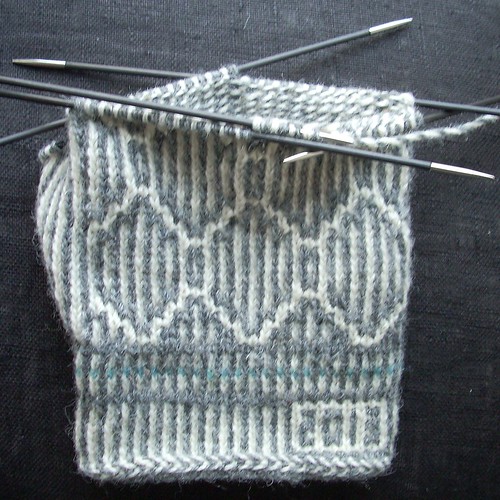
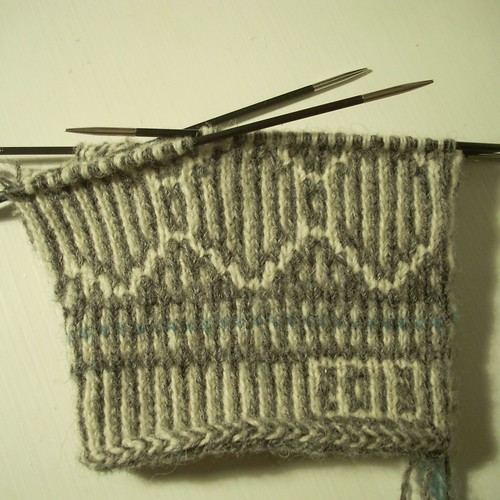
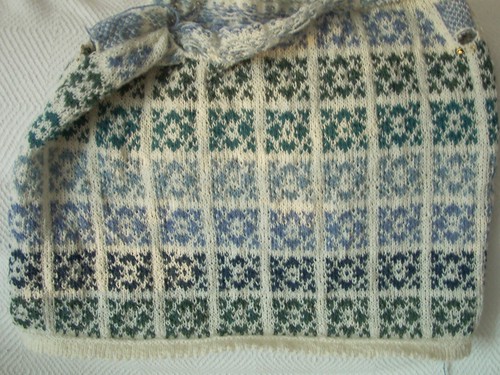
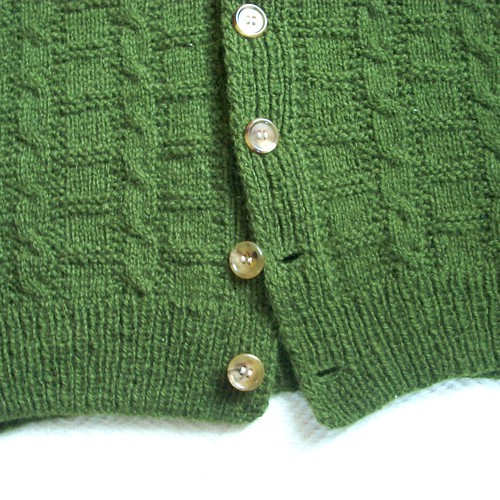
.jpg)

